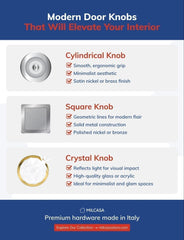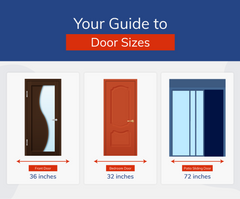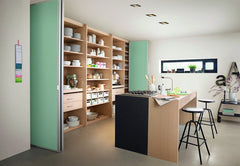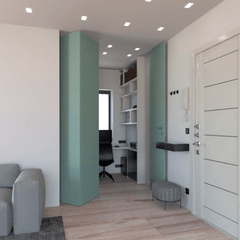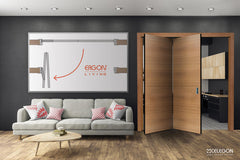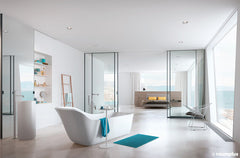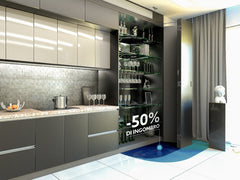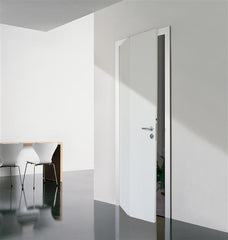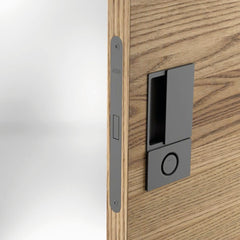
Top Benefits of Installing a Hidden Sliding Door in Modern Homes

The quest for both functionality and style has led homeowners and designers alike to embrace innovative solutions that maximize space without sacrificing aesthetics. Among these solutions, hidden sliding doors are a top choice.
Unlike traditional hinged doors that require clearance space to swing open, a hidden sliding door glides effortlessly along a track, disappearing into walls or sliding neatly alongside them. This ingenious design not only saves valuable square footage but also creates a seamless, contemporary look that enhances any living space. The wall mounted sliding door system represents the perfect marriage of form and function, offering a sleek alternative to conventional doors while providing practical benefits that extend far beyond mere appearances.
At Milcasa Store, we've witnessed firsthand the transformative power of hidden sliding door hardware in modern homes. Our systems are designed with attention to detail, ensuring smooth operation and long-lasting performance.
BROWSE THE MAGIC DOOR HARDWARE COLLECTION →
The beauty of a hidden sliding door lies in its versatility. Compatible with various wood types and available in different finishes including anodized silver, these innovative door systems can complement any interior design style – from minimalist modern to warm traditional. The hardware itself remains discreetly concealed, allowing the door to become a seamless part of your wall when closed or an elegant design statement when open.
Space-Saving Innovation
In today's housing market, where square footage comes at a premium, making the most of available space has become a top priority for homeowners. This is where the hidden sliding door truly shines as an innovative space-saving solution that can transform how you experience your home.
Hidden vs. Traditional Sliding Doors
Traditional swing doors require significant clearance space – typically at least 9 square feet – to open and close properly. This space often goes unused or becomes awkwardly filled with furniture positioned to accommodate the door's swing path. A wall mounted sliding door, by contrast, eliminates this wasted space entirely. The door simply glides parallel to the wall, either mounted on an external track or concealed within a pocket, freeing up valuable floor area that can be utilized for furniture, décor, or simply creating a more spacious feel.

Maximizing Space
The space-saving benefits of hidden sliding door systems are particularly valuable in compact urban apartments, where every square inch counts. In smaller bedrooms, bathrooms, or closets, where door width and min opening width requirements might otherwise pose challenges, a sliding solution allows for full access without sacrificing precious floor space. Even in larger homes, these systems provide design flexibility that traditional doors simply cannot match.
Related post: Making The Most Of Small Spaces: Doors, Storage, & Design
Consider a scenario where you want to separate a large living area into two distinct spaces occasionally. A pair of hidden sliding doors can provide this functionality without permanently dividing the room, allowing you to maintain an open-concept feel when desired and privacy when needed. The innovative track systems can be designed to accommodate various configurations, including single doors, bypassing doors, or even corner applications.
Related post: Interior Folding Doors: Saving Space and Stylish Design
Beyond Space-Saving
Beyond the practical space-saving aspects, hidden sliding doors contribute to a sense of openness and flow throughout your home. Without the visual interruption of traditional door frames and hardware, rooms feel more connected and spacious. The sleek, minimalist aesthetic of concealed sliding hardware creates clean lines that enhance the overall design, making spaces appear larger and more cohesive.
For homeowners looking to maximize resale value, the installation of high-quality hidden sliding door hardware represents a smart investment. These innovative systems signal to potential buyers that the home has been thoughtfully designed with both functionality and style in mind. As urban living spaces continue to shrink and the premium on efficient design grows, features that optimize space while enhancing aesthetics will only become more valuable.
Aesthetic Appeal and Design Versatility
When it comes to interior design, the details make all the difference. Hidden sliding doors represent one of those transformative elements that can elevate the entire aesthetic of your home while providing remarkable design versatility. Unlike traditional hinged doors that often interrupt visual flow, a concealed sliding door system creates clean, unbroken lines that contribute to a more sophisticated and cohesive interior.
Related post: Fight! Swing vs. Sliding Doors
When installed properly, the track, wheels, and other components remain out of sight, allowing the door itself to become the focal point—or to blend seamlessly with surrounding walls. This creates a sleek, minimalist look that's highly sought after in contemporary design. The wall mounted sliding door appears to float effortlessly, creating an almost magical effect that traditional doors simply cannot achieve.
Related post: Hidden Doors - Design Features
Wood doors are particularly stunning when paired with hidden sliding systems. The natural warmth and texture of wood creates a beautiful contrast against modern walls, while the concealed hardware ensures nothing distracts from the meticulously crafted door itself. From rich walnut and oak to lighter maple and pine, different wood types can dramatically change the character of the space. For those seeking a truly custom look, doors can be finished to match existing woodwork or to create a deliberate design statement.

The anodized silver finish available on many hidden sliding door hardware components offers a subtle, sophisticated touch that complements a wide range of interior styles. This durable finish not only looks elegant but also provides excellent resistance to scratches and wear, ensuring your sliding system maintains its beauty for years to come. For those who prefer different aesthetics, other finishes like matte black or brushed nickel may also be available to match your interior hardware.
Related post: A Comprehensive Guide To The Different Types Of Door Hardware
If you appreciate the illusion of more space, hidden sliding doors are unmatched. By eliminating the visual clutter of traditional door hardware and creating clean sight lines throughout the home, these innovative solutions make spaces feel larger, more open, and more deliberately designed.
Smooth Operation and Functionality
At the heart of any quality hidden sliding door system is the track and wheel mechanism that allows for effortless movement. Unlike traditional hinged doors that can swing heavily or catch on uneven floors, a properly installed sliding system glides with minimal effort. The best hidden sliding door hardware features precision-engineered components that work together seamlessly to create this smooth operation.
Soft Close Feature
The soft close feature represents one of the most significant advancements in sliding door technology. Similar to the soft-close mechanisms found in high-end kitchen cabinetry, this innovation prevents doors from slamming shut or bouncing back open. Instead, as the door approaches the closed position, the mechanism gently decelerates its movement, pulling it to a smooth, silent close. This not only prevents noise disruption but also protects the door and hardware from the wear and tear of abrupt stops.

For families with children or pets, the soft close functionality provides an added safety benefit, eliminating the risk of pinched fingers or startling noises. The end operation of the door becomes virtually foolproof, with the door settling perfectly into position every time. This attention to the user experience is what separates premium hidden sliding door hardware from basic sliding systems.
Rolling Wheels
The wheels component of the system deserves special attention, as these are critical to the door's performance. High-quality concealed sliding systems utilize precision-machined rollers, often with ball bearings that ensure consistent, smooth movement even with heavier wood doors. These rollers are typically designed to be compatible with doors of various thicknesses, allowing for flexibility in your design choices.
Left/Right Handed Configuration
Right handed doors and left handed configurations are equally accommodated in well-designed systems, with the track and hardware adaptable to your specific layout needs. This versatility extends to the installation options as well, with systems available for both wall mounted applications and ceiling-mounted tracks, depending on your architectural requirements and aesthetic preferences.
Rail Length
The rail length is another important consideration that impacts functionality. Properly sized rails ensure the door can open completely, providing full access to the doorway. The sliding system should allow the door to travel smoothly along the entire rail without catching or hesitating at any point. Premium systems often feature adjustable components that allow for fine-tuning during and after installation, ensuring optimal performance over time.
Privacy & Sound
For those concerned about privacy and sound insulation, many hidden sliding door systems can be equipped with specialized seals and closers that minimize gaps when the door is closed. While not providing the same level of sound isolation as a solid hinged door with compression seals, modern sliding systems have made significant improvements in this area, making them suitable for bedrooms, offices, and other spaces where privacy is desired.
Installation Considerations
Installing a hidden sliding door system requires careful planning and attention to detail to ensure optimal performance and longevity. Whether you're a DIY enthusiast or planning to hire a contractor, understanding the key installation considerations will help you achieve the best results with your wall mounted sliding door.
Accurate Measurements
First and foremost, accurate measurements are critical to the success of your installation. Door width, door thickness, and the min opening width of your doorway must all be precisely measured before ordering your hidden sliding door hardware. Most systems are designed to accommodate standard door thicknesses between 1-3/8" and 1-3/4", but always verify the specifications for your particular hardware. The door width will determine the appropriate rail length needed, which typically extends beyond the door width to allow for complete opening.
The structural integrity of the mounting surface is another crucial consideration. Hidden sliding door hardware must be securely attached to either wall studs or solid blocking to support the weight of the door. Wood doors, especially solid core varieties, can be quite heavy, with some weighing up to 80 kg (176 lbs). The mounting hardware must be capable of supporting this weight without sagging or pulling away from the wall over time.

Precision
Precision is key. The track must be perfectly level to ensure smooth operation of the sliding system. Even minor deviations can cause the door to drift open or closed on its own, or create resistance that affects the door's movement. Most quality hidden sliding door kits come with detailed installation templates and instructions that should be followed meticulously.
For those considering a DIY approach, it's important to assess your skill level honestly. While the basic concept of installing a wall mounted sliding door is straightforward, the precision required and the potential for costly mistakes might make hiring a professional contractor the more economical choice in the long run. A skilled installer will have the necessary tools and experience to ensure your concealed sliding system is installed correctly the first time.
If you do decide to hire a professional, look for contractors with specific experience installing hidden sliding door hardware. Ask to see examples of their previous work and check references. An experienced installer will be familiar with common challenges and solutions, ensuring your installation goes smoothly.
Floor Guide
The floor guide component of your sliding system also requires careful consideration. While the primary weight of the door is supported by the overhead track, a floor guide helps prevent the door from swinging away from the wall. This component must be precisely aligned with the overhead track to prevent binding or resistance during operation.
For doorways with non-standard dimensions, custom solutions may be necessary. Some hidden sliding door systems offer adjustable components that can accommodate variations in opening sizes, while others may require custom fabrication. Discussing these details with your supplier or contractor before purchasing will help avoid unexpected complications during installation.
Remember that proper installation is not just about functionality but it also affects the aesthetic outcome of your project. The goal of a hidden sliding door is to create a sleek, seamless appearance, which can only be achieved when all components are installed with meticulous attention to detail and proper alignment.
Choosing the Right Hidden Sliding Door System
Selecting the perfect hidden sliding door hardware for your home requires careful consideration of several factors to ensure you get a system that meets both your aesthetic preferences and functional needs. With various options available on the market, understanding the key differences can help you make an informed decision that you'll be satisfied with for years to come.
Type of Installation
The first consideration should be the type of installation that best suits your space and requirements. Wall mounted sliding door systems, where the door slides along the wall surface, offer the simplest installation and work well in most situations. These systems feature visible tracks mounted above the doorway, though the hardware is typically sleek and minimalist.
Alternatively, pocket door systems allow the door to slide completely into the wall cavity, creating a truly hidden door when open. While offering the cleanest look, pocket doors require more extensive construction as they need a hollow wall cavity sized appropriately for the door.
Related post: Types Of Sliding Doors
Door Dimensions
Door dimensions play a crucial role in selecting the right hardware. The door width, door thickness, and weight will determine which sliding system can properly support your door. Most quality hidden sliding door hardware is designed to accommodate standard door thicknesses between 1-3/8" and 1-3/4", but always check the specifications. For wider or heavier doors, you'll need more robust hardware with higher weight capacity. Be sure to consider the min opening width required for your doorway as well, as this will affect accessibility and functionality.
The track and rail length must be appropriate for your door size and the available wall space. For a door to open completely, the rail must extend approximately twice the door width (for wall-mounted systems). If you have limited wall space on one side, consider systems designed for asymmetrical openings or those that allow for doors to overlap when open.
Materials
Material quality is perhaps the most important factor in ensuring smooth operation and longevity. Look for systems with metal tracks and rollers featuring ball bearings for the smoothest glide. The wheels component should be precision-engineered and made from durable materials that won't degrade over time. Cheaper systems often use plastic components that may wear quickly or create noise during operation.

The soft close feature has become increasingly popular and is worth the investment for frequently used doors. This mechanism prevents slamming and ensures gentle, controlled closure every time. Some premium systems offer soft close in both directions (opening and closing), providing the ultimate in convenience and protection for your doors.
Consider the finish of the visible hardware components, even though much of the system will be concealed. Anodized silver is a popular choice for its durability and modern appearance, but other finishes like matte black or brushed nickel might better complement your interior design. The finish should be not only attractive but also resistant to scratches and wear.
Installation
Installation complexity is another important consideration, especially if you're planning a DIY project. Some hidden sliding door kits come with comprehensive installation templates and detailed instructions, making them more accessible to experienced homeowners. Others may require specialized tools or professional installation. Be realistic about your skills and the tools you have available before committing to a particular system.
Finally, consider the long-term value rather than focusing solely on initial prices. A high-quality hidden sliding door system is an investment in your home that should provide trouble-free operation for many years. Premium systems with features like soft close mechanisms, adjustable components, and durable materials may cost more initially but often prove more economical over time by eliminating the need for repairs or replacement.
Milcasa’s Take on Hidden Sliding Doors
At Milcasa Store, we're passionate about helping homeowners discover the hidden sliding door systems. Our collection features premium, Italian-made hardware that combines innovative engineering with sleek design for the ultimate in both functionality and style.
We invite you to explore our complete range of barn and sliding door hardware, including our signature Magic 2 system for wood doors. Our products are meticulously crafted with attention to every detail, from the precision-engineered wheels to the soft close mechanisms that ensure smooth operation for years to come.
BROWSE THE MAGIC DOOR HARDWARE COLLECTION →
Transform your home with the perfect balance of form and function—discover the Milcasa difference today.



